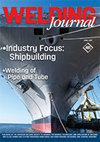Capacitor Discharge Spot Welding of Aluminum, Part 2: Electrode Life Assessments
IF 1.4
3区 材料科学
Q2 METALLURGY & METALLURGICAL ENGINEERING
引用次数: 1
Abstract
A major challenge for high-volume resistance spot welding of aluminum sheet is durability of the electrodes themselves. In production today, electrodes have total anticipated lives (including dressing) on the order of 1000 welds. This is largely related to the use of medium-frequency direct current (MFDC) power. The single-polarity orientation of MFDC welding results in excessive heating of one electrode (anode) and accelerated wear rates. Recently, technology employing capacitor discharge (CD) welding in conjunction with polarity switching has been developed. This work is the first effort in examining the response of resistance spot welding on aluminum sheet using this power source. Part 1 of this research (Ref. 1) described basic process robustness in spot welding with CD power systems. Part 2 addresses electrode life response. Duplicate electrode life tests were completed for 2000 welds without failure. These results were related to the polarity switching and short time that produced balanced and minimized wear. Additional testing was done without the use of electrode-cooling water. A limited test (500 welds) largely paralleled the ones done with cooling, suggesting that long-term spot welding with polarity-switching CD power and no water was possible.铝电容器放电点焊,第2部分:电极寿命评估
铝板大容量电阻点焊的主要挑战是电极本身的耐用性。在今天的生产中,焊条的预期总寿命(包括修整)约为1000个焊缝。这在很大程度上与中频直流电(MFDC)功率的使用有关。MFDC焊接的单极性取向导致一个电极(阳极)的过度加热和加速磨损率。最近,已经开发出将电容器放电(CD)焊接与极性切换相结合的技术。这项工作是首次研究使用这种电源在铝板上进行电阻点焊的响应。本研究的第1部分(参考文献1)描述了CD电源系统点焊的基本工艺稳健性。第2部分涉及电极寿命响应。完成了2000个焊缝的重复电极寿命测试,没有出现故障。这些结果与极性切换和产生平衡和最小化磨损的短时间有关。在不使用电极冷却水的情况下进行额外的测试。有限的测试(500个焊缝)在很大程度上与冷却测试平行,这表明使用极性切换CD电源和无水进行长期点焊是可能的。
本文章由计算机程序翻译,如有差异,请以英文原文为准。
求助全文
约1分钟内获得全文
求助全文
来源期刊

Welding Journal
工程技术-冶金工程
CiteScore
3.00
自引率
0.00%
发文量
23
审稿时长
3 months
期刊介绍:
The Welding Journal has been published continually since 1922 — an unmatched link to all issues and advancements concerning metal fabrication and construction.
Each month the Welding Journal delivers news of the welding and metal fabricating industry. Stay informed on the latest products, trends, technology and events via in-depth articles, full-color photos and illustrations, and timely, cost-saving advice. Also featured are articles and supplements on related activities, such as testing and inspection, maintenance and repair, design, training, personal safety, and brazing and soldering.
 求助内容:
求助内容: 应助结果提醒方式:
应助结果提醒方式:


